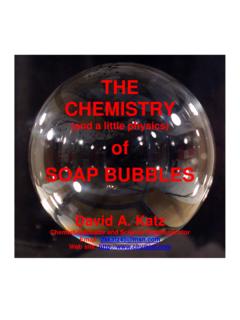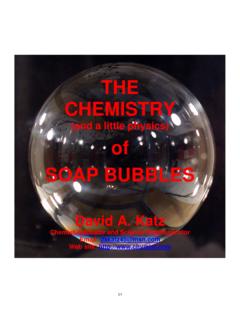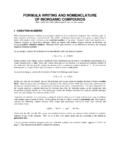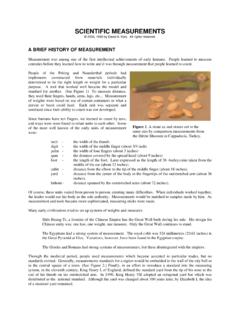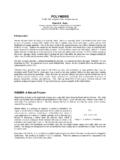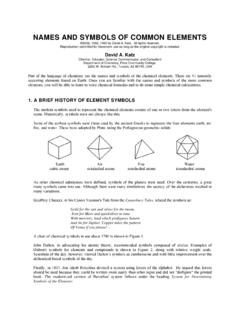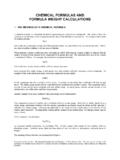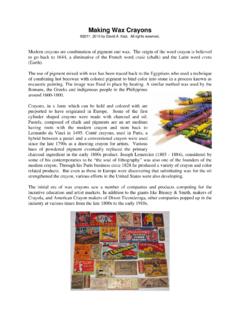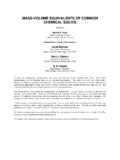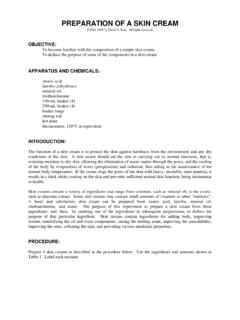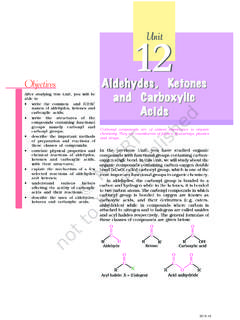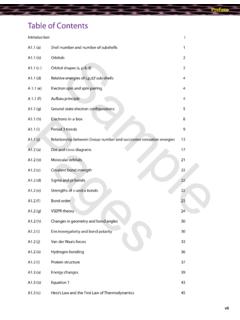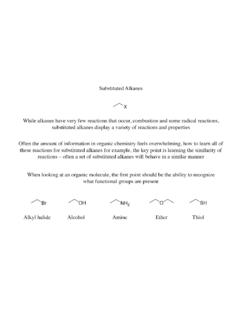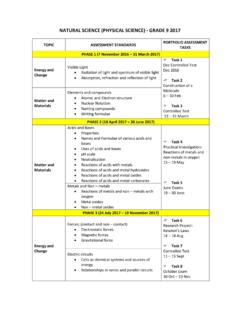Transcription of NOMENCLATURE OF ORGANIC COMPOUNDS - …
1 1 NOMENCLATURE OF ORGANIC COMPOUNDS 2010, 2003, 1980, by David A. Katz. All rights reserved. ORGANIC chemistry is the chemistry of carbon COMPOUNDS . Carbon has the ability to bond with itself to form long chains and, as a result, millions of COMPOUNDS from simple hydrocarbons to large biomolecules such as proteins, lipids, carbohydrates, and nucleic acids. Originally it was believed that these COMPOUNDS had to come from a living organism, now they are synthesized in the laboratory.
2 The simplest ORGANIC COMPOUNDS are composed of carbon and hydrogen and are known as hydrocarbons. There are four types, or classes, of hydrocarbons: Alkanes: contain all C-C single bonds. These are known as saturated hydrocarbons. Alkenes: contain at least one C=C double bond. Alkynes: contain at least one C C triple bond. Both alkenes and alkynes are known as unsaturated hydrocarbons Aromatic hydrocarbons: contain a benzene structure Lewis structures of alkanes look like this: These are also called structural formulas.
3 Since these take up a lot of space, condensed structural formulas are used. Even simpler than condensed structures are skeletal or line structures: There are a range of structures used to represent ORGANIC COMPOUNDS : Before we start naming ORGANIC COMPOUNDS , it is important to understand how carbon atoms are bonded. Every carbon atom will try to form 4 bonds. A carbon atom on the end of a chain of single bonded carbon atoms will be bonded to one carbon atom and three hydrogen atoms: H C C H H 2 A carbon atom in the middle of a chain of single bonded carbon atoms will be bonded to two carbon atoms and two hydrogen atoms.
4 A carbon atom bonded to 3 other single bonded carbon atoms will be bonded to one hydrogen. A carbon atom on the end of a chain that is double bonded to another carbon atom be bonded to two hydrogen atoms. A carbon atom in the middle of a chain of that is double bonded to another carbon atom will be bonded to one carbon atom and one hydrogen atom. A carbon atom on the end of a chain that is triple bonded to another carbon atom will be bonded to one hydrogen atom. The second carbon atom in that chain is only bonded to another carbon atom, but no hydrogen atoms.
5 I. naming Saturated Hydrocarbons - The Alkanes The names of the alkanes are derived from the Greek prefix for the particular number of carbon atoms in the compound with an -ane ending. The names of the first ten alkanes are given in the following table. H C C C H C C C C H C C \ H H C C C H H H C C C C C C C H 3 Not all the alkanes are straight chained COMPOUNDS .
6 As shown in the previous table, they can have side chains or branches. These variations of COMPOUNDS which have the same number of carbon and hydrogen atoms, but a different arrangement are known as isomers. Some isomers are shown in the diagram below. Rules for naming of Branched Hydrocarbons. There are four parts to the name of a branched hydrocarbon 1. The parent chain: Tells how many carbons are in the longest continuous chain. meth = 1 eth = 2 prop = 3 but = 4 pent = 5 2. The suffix: Tells what type of compound it is.
7 Ane = an alkane ene = an alkene yne = an alkyne 3. The prefix: Tells what groups, or branches are attached to the parent chain. methyl = CH3 ethyl = CH2 CH3 propyl = CH2 CH2 CH3 4. The location: Tells where groups, or branches, are attached to the parent chain. 2 = 2nd carbon atom 3 = 3rd carbon atom 4 = 4th carbon atom Note: alkyl groups, or branches cannot be located on the 1st or last carbon 4 Example 1: CH3-CH-CH2-CH-CH3 CH3 CH3 1. Select as the parent chain the LONGEST CONTINUOUS CHAIN of carbon atoms.
8 The compound is considered to have been derived from the parent structure by the replacement of hydrogens by various alkyl groups. CH3-CH-CH2-CH-CH3 CH3 CH3 The longest continuous chain of carbon atoms in this example contains five carbon atoms. Since the carbon atoms in this compound all contain The alkane that contains five carbon atoms is pentane. 2. Identify the branches, or side chains, attached to the parent chain. CH3-CH-CH2-CH-CH3 CH3 CH3 Both branches consist of single carbon atoms, there are called methyl groups 3.
9 Starting from either end of the longest carbon chain, number the carbon atoms in the parent chain consecutively so that the alkyl groups (or branches) are attached to the carbon atoms with the lowest possible numbers. 1 2 3 4 5 CH3-CH-CH2-CH-CH3 CH3 CH3 For this compound , it makes no difference which end you start the numbering. In both cases the alkyl groups, or branches are attached to the second and fourth carbon atoms in the parent chain.
10 4. Name the compound in order of: number of carbon atom-alkyl group attached(number of carbon atom-alkyl group attached- ) name of parent compound . If there are several different alkyl groups attached to the parent chain, name them in order of increasing size or in alphabetical order. The name for this compound looks like it would be called would be called 2-methyl-4-methylpentane, however, all branches with the same name are grouped together. The number of these branches have a prefix.
